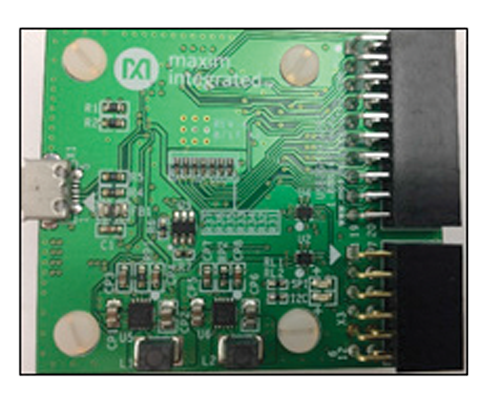The USB2GPIO# adapter board is designed to work
with Maxim’s Munich GUI and to connect to various EV
kit or Pmod boards with Pmod™ compatible connectors
for I2C/SPI/GPIO communication to test and evaluate
different Maxim ICs. This document explains how the
USB2GPIO# adapter board receives commands from
a laptop through the USB to create an I2C/SPI/GPIO
interface. The Maxim USB2GPIO# board requires the
Munich GUI which can be downloaded from Maxim’s
website free of charge.
The USB2GPIO# design is powered directly from the USB
bus power (5V) and integrates two low-power, 1.2A, PWM
step-down DC-DC converters (MAX1556) to provide
programmable VCC voltages of 1.8V, 2.5V, 3.3V, or 5.0V.
A dual, high-speed, USB-to-multipurpose UART/FIFO IC
(FT2232HQ), high-speed USB switches (MAX4983), and
a 4K MICROWIRE-compatible serial EEPROM are the
other ICs on this adapter board.
USB2GPIO# is designed to supersede USB2PMB1# and
USB2PMB2# adapters and includes two connectors;
connector X3 is a 12-pin connector which supports either
I2C with 6 GPIO pins, or SPI with 4 GPIO pins, and is
fully compatible with previous adapters and low-pin count
EV kit or Pmod boards. This connector is controlled from
the Munich GUI. The addition of another connector, X2,
which is a 20-pin connector allows either 16 extra GPIO
connections or a second SPI port and 12 extra GPIO
connections. This 20-pin connector is NOT controlled by
Munich GUI but is for use with future EV kits and will be
controlled by the relevant EV kit GUIs.
This USB2GPIO# adapter board can be used to enable
USB-to-I2C/SPI interface for any Pmod-compatible plug-in
peripheral modules such as the Maxim MAX14001PMB#,
and MAXREFDES12 – Corona reference designs. In
addition, it can be ordered together as an evaluation
system (EV system) with different EV kits, such as
MAX14001EVKIT#. Note that an “EV system” is an EV kit
combined with an interface board, such as a USB2GPIO#
and EV kit GUI software. Ordering information for EV
systems is included in the EV kits’ corresponding data
sheet. Refer to the appropriate EV kit data sheet for quick
start and detailed operating instructions.
The USB2GPIO# has been tested on Windows® 7,
Windows 8, and Windows 10 system using Munich GUI,
Version 2.17 or later.
Applications
- Cell Phones/Smartphones
- Digital Cameras and Camcorders
- Handheld Instruments
- PDAs and Palmtop Computers
- Portable MP3 and DVD Players




